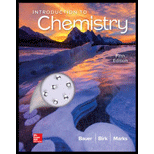
Concept explainers
(a)
Interpretation:
The given statement, “a hydrocarbon that contains one or more localized carbon-carbon double bonds�, is to be matched to its appropriate key term.
(b)
Interpretation:
The given statement, “an organic compound containing an oxygen doubly bonded to a carbon, which is also bonded to two other carbons
(c)
Interpretation:
The given statement, “an organic compound containing the
(d)
Interpretation:
The given statement, “a reactive part of a molecule that undergoes characteristic reactions�, is to be matched to its appropriate key term.
(e)
Interpretation:
The given statement, “a hydrocarbon containing one or more triple bonds�, is to be matched to its appropriate key term.
(f)
Interpretation:
The given statement, “an organic compound that contains the
(g)
Interpretation:
The given statement, “an aromatic group formed by the removal of a hydrogen atom from a cyclic aromatic hydrocarbon�, is to be matched to its appropriate key term.
(h)
Interpretation:
The given statement, “a cyclic hydrocarbon with delocalized bonding that imparts special stability�, is to be matched to its appropriate key term.
(i)
Interpretation:
The given statement, “a compound that contains only carbon and hydrogen�, is to be matched to its appropriate key term.
(j)
Interpretation:
The given statement, “a hydrocarbon that contains all the hydrogens it can hold�, is to be matched to its appropriate key term.
(k)
Interpretation:
The given statement, “a hydrocarbon that has a straight or branched chain structure with only single bonds�, is to be matched to its appropriate key term.
(l)
Interpretation:
The given statement, “an organic base with one or more alkyl groups bonded to a nitrogen atom�, is to be matched to its appropriate key term.
Want to see the full answer?
Check out a sample textbook solution
Chapter 16 Solutions
Introduction To Chemistry
- TRUE OR FALSE (a) A functional group is a group of atoms in an organic molecule that undergoes a predictable set of chemical reactions. (b) The functional group of an alcohol, an aldehyde, and a ketone have in common the fact that each contains a single oxygen atom. (c) A primary alcohol has one —OH group, a secondary alcohol has two —OH groups, and a tertiary alcohol has three —OH groups. (d) There are two alcohols with the molecular formula C3H8O. (e) There are three amines with the molecular formula C3H9N. (f) Aldehydes, ketones, carboxylic acids, and esters all contain a carbonyl group. (g) A compound with the molecular formula of C3H6O may be either an aldehyde, a ketone, or a carboxylic acid. (h) Bond angles about the carbonyl carbon of an aldehyde, a ketone, a carboxylic acid, and an ester are all approximately 109.5°. (i) The molecular formula of the smallest aldehyde is C3H6O, and that of the smallest ketone is also C3H6O. (j) The molecular formula of the smallest carboxylic…arrow_forwardThe following is a structural diagram for penicillin G, an antibiotic compound with outstanding antibacterial activity. It is obtained from the liquid filtrate of molds. HO H H H C-C N- H Penicillin G can be described as an Organic Co -N- organic inorganic CH₂ H CH₂ -COOH compound. One functional group found in penicillin G is the ◆ grouparrow_forward(a) What structural feature is associated with each type of hydrocarbon: alkane, cycloalkane, alkene, and alkyne?(b) Give the general formula for each type.(c) Which hydrocarbons are considered saturated?arrow_forward
- (a) Is C4H6 a saturated or unsaturated hydrocarbon?(b) Are all alkynes unsaturated?arrow_forwardIndicate whether each statement is true or false. (a) Pentanehas a higher molar mass than hexane. (b) The longer the linearalkyl chain for straight-chain hydrocarbons, the higherthe boiling point. (c) The local geometry around the alkynegroup is linear. (d) Propane has two structural isomers.arrow_forwardExplain each statement in terms of atomic properties:(a) Carbon engages in covalent rather than ionic bonding.(b) Carbon has four bonds in all its organic compounds.(c) Carbon forms neither stable cations, like many metals, norstable anions, like many nonmetals.(d) Carbon bonds to itself more extensively than does any otherelement.(e) Carbon forms stable multiple bondsarrow_forward
- (B) Draw a structural diagram for each of the following organic compounds: (a) 2-ethyl-4-methyl-2-pentanol (b) 1,2-ethandiol (c) 1,3-dimethylbenzenearrow_forwardName or write the condensed structural formula for the following compounds:(a) 4-methyl-2-pentene (b) cis-2,5-dimethyl-3-hexenearrow_forwardWrite a condensed structural formula, such as CH3CH3, and describe the molecular geometry at each carbon atom.(a) 2-propanol(b) acetone(c) dimethyl ether(d) acetic acid(e) 3-methyl-1-hexenearrow_forward
- Write the Lewis structure and molecular formula for each of the following hydrocarbons:(a) hexane(b) 3-methylpentane(c) cis-3-hexene(d) 4-methyl-1-pentene(e) 3-hexyne(f) 4-methyl-2-pentynearrow_forwardDraw the structural formula for each of the following compounds: (a) 2,3-dimethyloctane (b) 3-ethylheptane (c) 2,5-dimethylhexane (d) C2H4 (e) 2,2-dimethylbutanearrow_forwardIsooctane is the common name of the isomer of C8H18 used as the standard of 100 for the gasoline octane rating: (a) What is the IUPAC name for the compound?(b) Name the other isomers that contain a five-carbon chain with three methyl substituents.arrow_forward
 Chemistry & Chemical ReactivityChemistryISBN:9781133949640Author:John C. Kotz, Paul M. Treichel, John Townsend, David TreichelPublisher:Cengage Learning
Chemistry & Chemical ReactivityChemistryISBN:9781133949640Author:John C. Kotz, Paul M. Treichel, John Townsend, David TreichelPublisher:Cengage Learning Chemistry & Chemical ReactivityChemistryISBN:9781337399074Author:John C. Kotz, Paul M. Treichel, John Townsend, David TreichelPublisher:Cengage Learning
Chemistry & Chemical ReactivityChemistryISBN:9781337399074Author:John C. Kotz, Paul M. Treichel, John Townsend, David TreichelPublisher:Cengage Learning Chemistry for Today: General, Organic, and Bioche...ChemistryISBN:9781305960060Author:Spencer L. Seager, Michael R. Slabaugh, Maren S. HansenPublisher:Cengage Learning
Chemistry for Today: General, Organic, and Bioche...ChemistryISBN:9781305960060Author:Spencer L. Seager, Michael R. Slabaugh, Maren S. HansenPublisher:Cengage Learning Chemistry: The Molecular ScienceChemistryISBN:9781285199047Author:John W. Moore, Conrad L. StanitskiPublisher:Cengage Learning
Chemistry: The Molecular ScienceChemistryISBN:9781285199047Author:John W. Moore, Conrad L. StanitskiPublisher:Cengage Learning Chemistry: Principles and PracticeChemistryISBN:9780534420123Author:Daniel L. Reger, Scott R. Goode, David W. Ball, Edward MercerPublisher:Cengage Learning
Chemistry: Principles and PracticeChemistryISBN:9780534420123Author:Daniel L. Reger, Scott R. Goode, David W. Ball, Edward MercerPublisher:Cengage Learning





